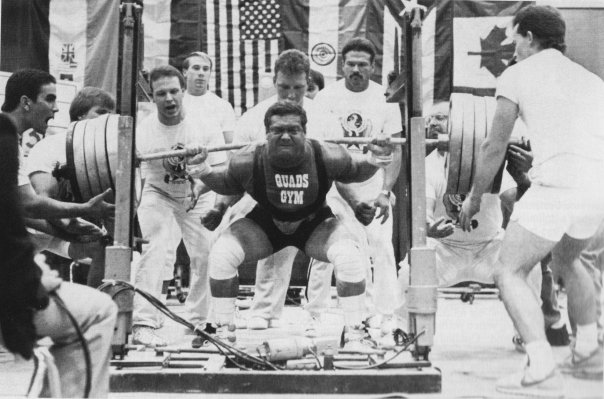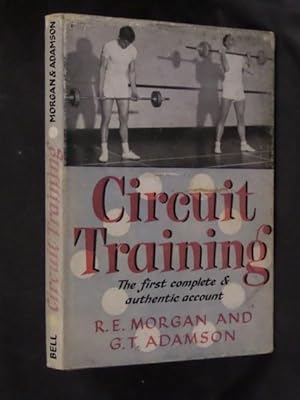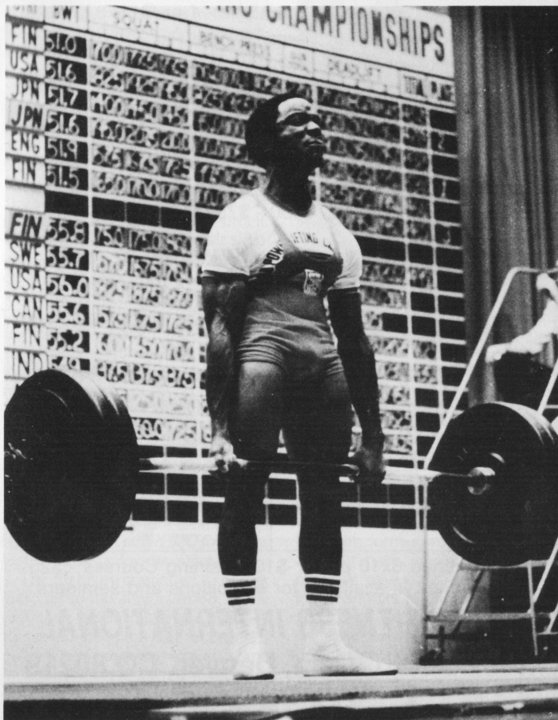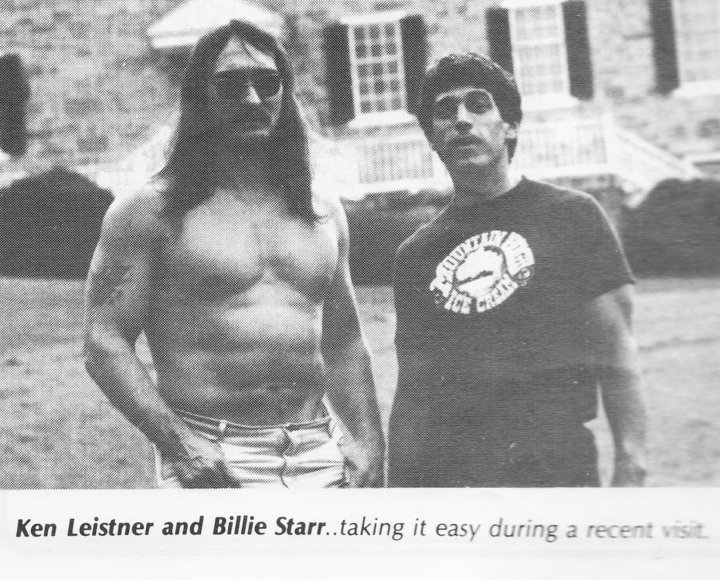Andy Bolton approaches his deadlift quickly, all the way, so his shins touch the bar. He can't wait -- the man known as The Jack cannot at this point retract the
fait accompli he set free. Like his lifts, his physical dynamics are the purest demonstration of Newtonian physics: a body in motion, stays in motion.
He plants his feet and brings his body upright for an instant, every muscle from his neck to his toes shuddering with energy. Without hesitation he bends slightly and locks on with an alternate grip, right hand first, then the left. His hips drop twice -- a dip, a dip, a snap of a pull and it's done. Fast, explosive, predictable: you could set the atomic clock by his precision.
The same every time.
Except this time. This is different. This is the World Powerlifting Congress World Championships/WPO Semi Finals at Lake George, New York, November 4, 2006, and Bolton is girded for Armageddon, attempting to rattle the bones of the sport's greatest legends so loudly that he will echo in eternity. His goal is the imponderable, a theoretically impossible feat of strength. Bolton is attempting to lift 1,003 pounds off the floor to a full, upright, proud and ramrod-straight position.
Think of it. Live muscle and connective tissue that you can tear by stepping in a sidewalk crack, and bone that you can break by falling out of your recliner, all coordinated by the human psyche with its own set of warts and wens -- and this bedlamite called Andy Bolton thinks he can raddle this crazy-quilt of infirmities together enough to pull half a ton of iron off the floor and walk away with all of his limbs still connected.
Bolton, though, comes from no known taxonomic order. At his birth 37 years ago in Dewsbury, Yorkshire, England, his family watched with stark amazement as baby Bolton's erumpant form bulged and grew in his crib seemingly before their very eyes. At 11 years old, Bolton's size and concussive athletic power made him one of the fastest 100 meter and 200 meter sprinters for his age in all of England. The more he sprinted, the more his midsection, legs, and lower back developed in strength and muscularity. Alas, as Bolton got bigger, he got slower; it wasn't long before he'd outgrown his sport.
Searching for his fate, he began playing rugby at 13 and made it to the national level before a back injury put him out of the game at age 17. Meanwhile, his growing continued. "I was big. I was strong," he bemusedly recall.
At 18, Bolton -- 6 feet, 230 pounds and fascinated by bodybuilding -- joined a gym and promptly was approached by the owner, who inquired if this was the first time he had tried lifting. "Yes," Bolton replied.
"Look how much weight you have on the bar," suggested the owner. Bolton had been squatting with 500 pounds and deadlifting more than 600.
"I didn't know what I was doing," Bolton ingenuously explains, "nor did I know anything about powerlifting. I only wanted to be a bodybuilder. From then on, I just exhausted one bodypart a day for 8 to 10 sets of 6 to 10 reps, five days a week, but always with the bench, squat, and deadlift, because I thought those were the basics for bodybuilding. Then, I'd add machines, cables and other 'little' movements.
For two years Bolton stayed the course, and in 1990 at age 20 he competed -- once. It was the British Championships, and he took third -- but it was revelatory. "I looked in the mirror and knew there was no way I was going to be Mr. Olympia," sighs Bolton, describing the realization that he was now free to pursue his gut-honest desideratum. "I had a thick waist, I didn't have a good chest, my arms weren't peaked; I've always trained as heavy and explosively as possible, always to an insane max, and I like training that way."
Fate took it from there. Back in the gym, Bolton noticed four guys -- one of whom weighed only about 180 -- all deadlifting 800 pounds, and benching and squatting proportionately. "I scratched my head and wondered why they were so strong and I wasn't," Bolton mused, "so I approached them. All this time, they said, they'd been keeping an eye on me. They could see I was strong, but they were waiting for me to make the move." One was Brian Reynolds, who won the world powerlifting championships in 1992 at age 21. Another was powerlifter Dave Carter. "They took me under their wings -- Bryan Reynolds wrote my first powerlifting workout for me -- and I still train with them today, all these years later," Bolton adds.
That initial workout was even simpler than what he had been doing:
Bench, shoulder, and triceps on Monday
Squats and Deadlifts on Wednesday
Legs, traps and upper back on Thursday.
This time, however, his mentors insisted on a fundamental change. "I was told in the beginning," Bolton recalls, "
to concentrate on technique and to not go too heavy, because that would result in faster progress without injuries."
He also cycled his workouts, first with two-week periods of 5 to 8 reps sets, another two weeks of 5 reps, one week of 3 rep sets, then a week of doubles or singles. The result? "Every time I started over with the next six-week cycle I'd be as much as 50 pounds stronger for every powerlifting movement," Bolton asserts. "The weights just flew up."
By 1994 strongman competitions had become the rage, and their TV exposure promised rock-star fame and fortune, plus proficuous release for Bolton's rampant power. So for the next five years he was a car tipper, rock lifter and train puller. He did okay. Twice, he was invited to compete in the World's Strongest Man competitions and twice was a no-show because of injuries. Nonetheless, he emerged as one of the top three strongmen in England.
More important, Bolton's strongman experience enhanced his base of explosive power and endurance. Notes Brian Batcheldor, Bolton's trainer: "When you look at the weights Andy handles, it's nigh impossible. Most people separate them. You couldn't squat with 900 pounds for reps, then on the same day start your pull, but Andy does. And, remember, he's doing 10-12 sets of 5 reps for each of those lifts. That's a lot of training in one workout, but that's the kind of conditioning a powerlifter needs. Some meets go on for five or six hours, and you can see by the guys who are falling by the wayside who's in shape and who isn't. They trained their squat and deadlift on different days; now, they have to pull everything together in one day.
Beginning 16 weeks out, Bolton deadlifts with a barbell elevated on a 1.5 inch board off the floor, which for him puts the bar shin high. "Your legs can't get into it," he says. "You can pull only with your back, but it's a good way to get your back strong." In this position Bolton pulled 905 pounds for 3 reps and 800 for 8.
From 8 weeks on in, he increases his deadlifts each week finishing two weeks out with an 8-set workout that ends with a triple at 750. The last 6 weeks are what he calls "Speed work -- about 70%, but exploding as fast as possible3. It's mostly about seeing how fast I can lift the weight off the ground."
Welsh poet Dylan Thomas wrote, "There is always the one right word; use it . . ." For Andy Bolton that word is "explosive" and, indeed, he uses it, until it reverberates through his conversation as a life force.
"When I'm training," Bolton says, "I pull as fast as possible --
so fast -- and when I lower it to my knees, I just drop it, then grab it and explode up again. Up quick and down fast, up quick and down fast. That builds explosive power." Batcheldor says that, even in a meet -- where Bolton's hands have to follow the bar down per rules -- his max lift comes off the floor at the same speed as he lowers it.
Bolton arrives in town seven to 10 days before a meet and inures himself to a simple constitutional of breakfast at about 9 A.M., followed by quiet time in his room, relaxation, a little TV or a leisurely walk to clear his head. At about 3 or 4 P.M. he'll go to bed for about two hours, then get up, go out to dinner with friends and talk about explosion and the big show. Bolton explains, "We'll talk about what other guys are doing, who's lifting what, but I won't talk much about myself. I'll keep that quiet. There are more people talking about me than me talking about me."
Afterward, he may rent a film to watch on the hotel TV, but he's normally in bed by 10 P.M. He used to sleep four to five hours, but he says he's pretty good now. He gets eight to 10 hours and he needs every minute of it: a powerlifter at this level works harder and lifts heavier in one meet than he does in a week's worth of workouts.
At the meet, Bolton reruns what has been rampaging through his mind for several weeks. "I can feel myself doing it and I've seen myself doing it so many times that I cannot fail. I'm scared of failure. My biggest fear is not doing the weight; it really is. It's a BIG fear. There's no way I cannot do it. If I'm trained, and if I'm ready, there's no way that weight cannot go up. It's crazy. I can just switch on instantly. I shake, I tremble, I get goose bumps -- there's no way you can train someone else to have that feeling. It comes from inside. I'll never give in."
There's a guy, Dave Beattie, a friend of mine, who has been traveling everywhere with me for five years, and before a lift he'll push everyone else away and stand in front of me, and he'll put his head against my head talk to me. He'll just tell me I'm the best, he knows I'm the best, and I'm to show everybody I'm the best. He reminds me that I've lifted well over 900 pounds in 15 different meets, so this is just the next natural progression. There's no way I can fail this way; I've been here a hundred times before. He'll just talk about such things and really get me hyped, and he'll start slapping me around the face a bit.
"When I grab the bar, I'm not even thinking about the weight. Techniques of tightness and power and explosion are going through my mind, but they're automatic, instinctual. They have to be that, rather than cognitive. The main thing that goes through my mind is just holding onto the bar, just tightening my grip so I don't lose it -- no straps -- but the technique seems to come of itself, from years and years and years of doing deadlifts.
"The arms are not really functional with this kind of weight. There's no way you can flex them to help, nor should you, so you just use your arms as hooks. They have to be totally relaxed. It's only from your wrists on down that you flex harder than you ever have in your life, for your grip. Try to bend your arms even on little bit and you'll tear your biceps straight off.
"Through the first few inches of the lift, I feel it in my hamstrings. Once I get it going to my shins and knee level, my lower back is really working; and when I start locking out, it goes to my traps.
"If it comes off the floor up to my knees, nine times our of 10 I'm going to lock it out. My weak part is down at the bottom. If it doesn't move off the floor, I'm not going to do it, but if it moves just slightly, that's when I start to relax a little bit, and I'll smile because I know it's going to go. I know it's working, but it's a big weight so I don't have a luxury; I know I have to fight it all the way to the top, but I know I've got it . . . I know I've got it . . . It's going . . . This one is going."
Bolton's achievement on November 4th, 2006 was certainly pure -- as in purely mind-blowing. And by all indications he's not done yet. Who knows how much further he or one of his fellow powerlifters can take it now that the 1,000 pound milestone has been passed? Powerlifting has always been a sport that celebrates the height of raw human achievement, and while this may have been its brightest moment yet, it's a sure bet there's even greater feats to come.
Bolton's Training Split
Monday:
Bench press, shoulders, triceps.
Tuesday:
Cardio.
Wednesday:
Squats, deadlifts.
Thursday:
Legs, upper back, traps.
Friday:
Cardio.
Saturday:
Cardio.
Sunday:
Rest.
Bolton's Off-Season Workout
Bench presses, squats, and deadlifts are performed for 8 to 10 sets each per workout, through a series of six-week mesocycles composed of 5 to 8 reps per set for 2 weeks, 5 reps per set for two weeks, 3 reps per set for one week, then 2 reps per set for one week.
Bench presses:
Bolton uses different grip widths, and/or boards of varying thickness on his chest, but no bench shirt.
Squats:
For each cycle, his lift varies: e.g., squatting in shorts with or without light knee wraps and a belt; undersuit, wraps and belt; undersuit, squat suit, belts and wraps (straps down; the straps on his suit will be pulled up for only one moderate workout before a meet).
Deadlifts:
The bar is lifted from 1.5 to 6 inch blocks, so his lower back, rather than legs, does most of the work. At 16 weeks out, the end of his off-season, Bolton pulls 905 pounds for 3 reps and 800 for 8 with dead stops and no lifting straps.
Cardio:
On off-days, he uses an exercise bike for 20-30 minutes at 80% max heart rate.
Monday:
Bench press assistance exercises -
Dumbbell front raise, 4-5 sets of 5-10 reps
Dumbbell lateral raise, 4-5 x 5-10.
Triceps assistance exercises -
Pushdown, 10-12 x 5-12 reps.
Wednesday:
Deadlift assistance exercises -
Clean pulls (high pulls), for one cycle with occasional 705-pound singles, 10-12 x 5 reps
Partial deadlifts (for a different cycle), 10-12 x 5 reps.
Thursday:
Leg assistance exercises -
Leg extension, 3-4 x 8-12
Leg press, 3-4 x 8-12
Seated calf raise, 3-4 x 8-12
Leg curl, 5 x 8-18 reps
Dumbbell side bend, very heavy, 5 x 12 reps.
Upper back assistance exercises -
Machine row, 6-7 x 10 reps
Dumbbell row, 220-pound dumbbell, 3 x 12-15 reps
Pulldown, 5 x 10
Shrug, 3-5 x 10.
Biceps assistance exercises -
Seated hammer curl, 5 x 10-12
Dumbbell curl, 4 x 10-12.
Bolton's Pre-Contest Deadlift Program
8 weeks out:
155 x 5
220 x 5
310 x 5
400 x 5
484 x 5
396 x 3 x 3
7 weeks out:
155 x 5
265 x 5
353 x 5
440 x 5
530 x 5
420 x 3 x 3
6 weeks out:
155 x 5
220 x 5
310 x 5
400 x 5
484 x 5
575 x 3
440 x 3 x 3
5 weeks out:
155 x 5
265 x 5
342 x 5
440 x 5
530 x 3
618 x 3
463 x 3 x 3
4 weeks out:
155 x 5
220 x 5
310 x 5
400 x 5
484 x 5
575 x 3
662 x 3
484 x 3 x 3
3 weeks out:
155 x 5
220 x 5
310 x 5
400 x 5
484 x 3
575 x 3
640 x 3
706 x 3
2 weeks out:
155 x 3
265 x 3
353 x 3
440 x 3
530 x 3
596 x 3
662 x 3
750 x 3
- During weeks 8 to 4 deadlifts are performed explosively, no suit.
- Week 3, suit on/straps down.
- Week 2, suit on/straps up.
Bolton's Advice for Beginners
Start with a Monday/Wednesday/Friday schedule. This program sticks to the basics. You should concentrate on technique. The strength increases will come later -- and faster -- if you have good technique, which means speed, explosiveness, concentration, and coordination. Those will also carry you a lot further than if you try to lift too heavy too soon. For each exercise, start light, with plenty of warmups and pyramid gradually.
A Sample Beginner Routine
Monday:
Bench press, 6-8 sets of 6-12 reps
Dumbbell front raise, 3-4 x 6-12 reps
Dumbbell lateral raise, 3-4 x 6-12
Triceps pushdown, 6-8 x 6-12.
Tuesday:
Cardio.
Wednesday:
Squat, 6-8 x 6-12
Deadlift, 6-8 x 6-12
Clean pull (high pull), 3-4 x 6-12.
Thursday:
Cardio.
Friday:
Leg extension, 3-4 x 6-12
Leg press, 3-4 x 6-12
Standing calf raise, 3-4 x 6-12
Leg curl, 3-4 x 6-12
Pulley or machine row, 3-4 x 6-12
Dumbbell row, 3-4 x 6-12
Pulldown, 3-4 x 6-12
Shrug, 3-4 x 6-10
Hammer curl, 3-4 x 6-12
Dumbbell curl, 3-4 x 6-12.
Saturday:
Cardio.
Sunday:
Rest.

















































